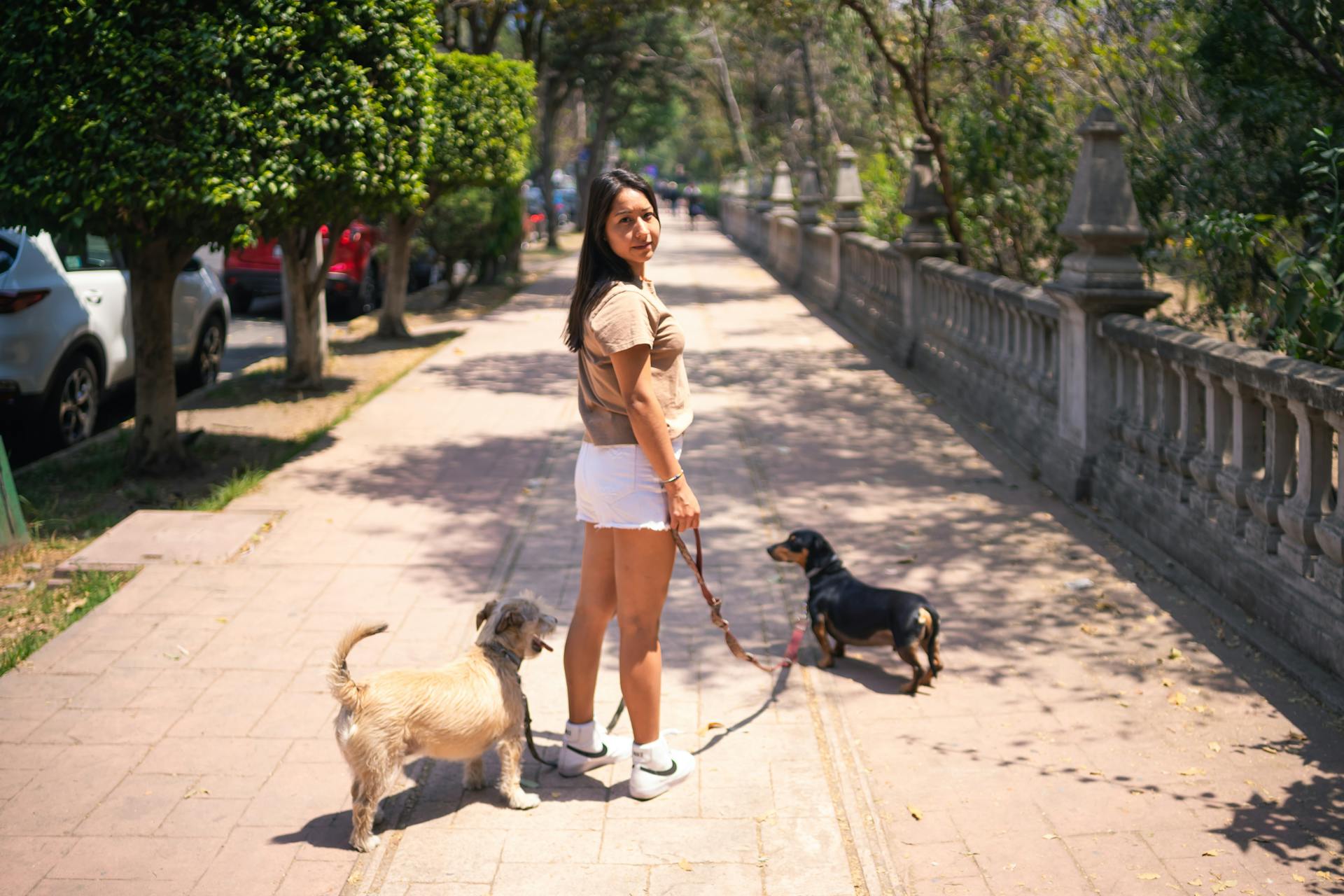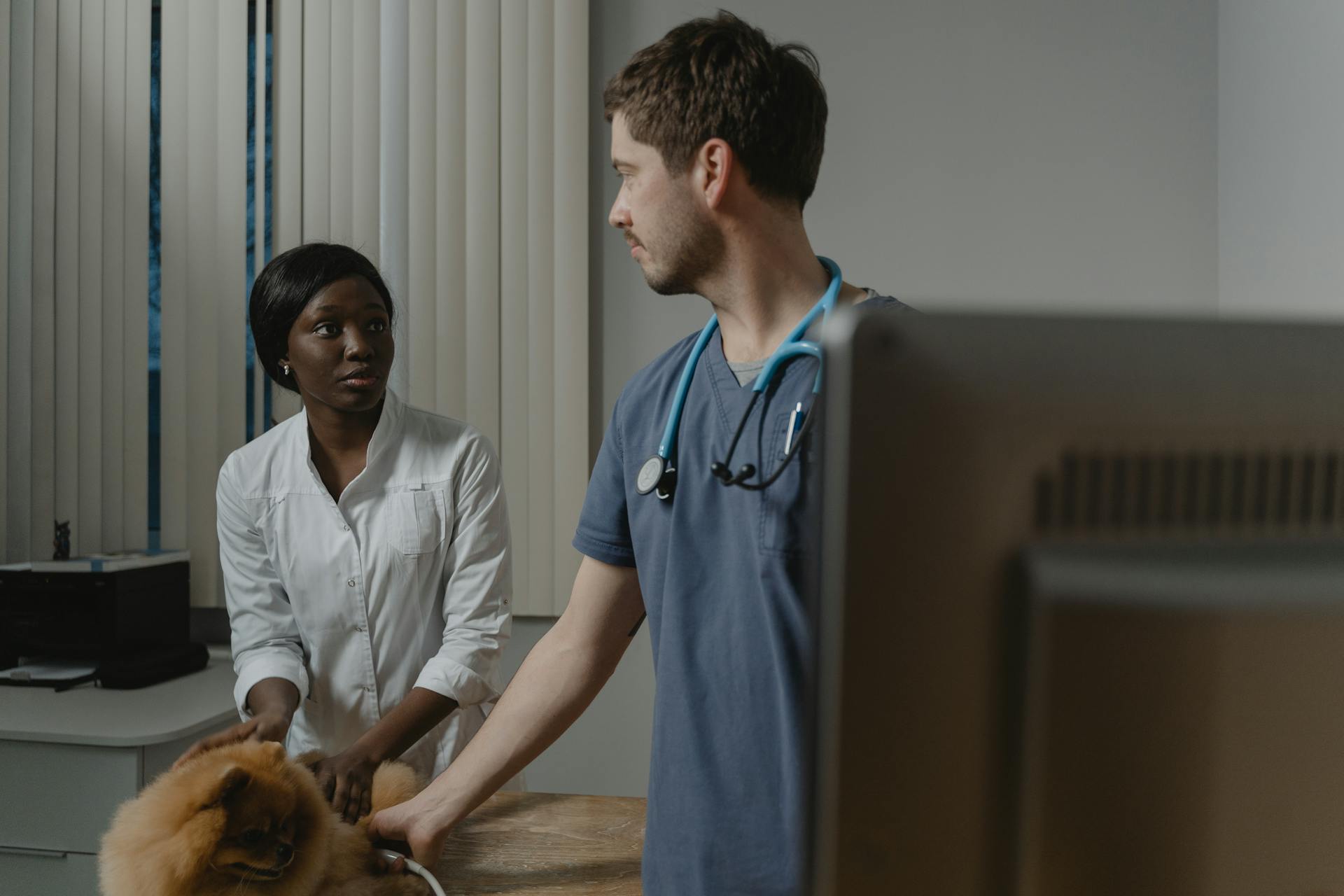
Hypertrophic osteodystrophy in dogs is a painful and potentially debilitating condition that affects young, large-breed dogs.
The condition typically affects dogs between 2 and 9 months old, with males being more commonly affected than females.
Symptoms can include lameness, swelling, and pain in the legs, as well as a reluctance to move or bear weight.
The exact cause of hypertrophic osteodystrophy is unknown, but it's thought to be linked to a combination of genetic and environmental factors.
Dogs with hypertrophic osteodystrophy may also experience fever, lethargy, and a decreased appetite.
In severe cases, the condition can lead to joint damage and long-term mobility issues.
Clinical Features and Diagnosis
Hypertrophic osteodystrophy, or HOD, is a condition that affects young, skeletally immature large- and giant-breed dogs.
The primary characteristic of HOD is lameness, which can range from mild limping to a reluctance or inability to stand. This is often due to the swelling of the metaphysis of the long bones, particularly in the front legs.
Lameness in HOD puppies can be accompanied by pain upon palpation of affected bones, warmth in the limb, depression, and loss of appetite. Limb involvement is usually bilateral, typically involving the distal radius and ulna, and may be episodic.
A "cow-hocked" stance has been observed in some breeds and/or individuals, while shaking of limbs and a reluctance to put full body weight on the front legs are common symptoms. Some puppies may also exhibit a characteristic "roaching" or arching of the spine when standing.
Your veterinarian will ask you many questions to develop a complete history of the disease, including when the problem started, which limb or limbs are affected, and any medication treatment. They will also examine your dog completely to determine the source of the lameness and check for a fever.
X-rays (radiographs) of the legs are taken to confirm the diagnosis of HOD, as they show the typical changes associated with the condition.
A complete physical exam is performed by your veterinarian, examining all four legs carefully, and taking your dog's temperature to check for a fever. Specific tests may include radiographs (X-rays) and blood tests to check your dog's hydration status and electrolyte levels.
For another approach, see: Canine Distemper Symptoms in Puppies
Here are the typical radiographic signs of HOD:
- Radiographs show typical changes associated with HOD in the radius and ulna bones of the forelimb in the area near the carpus (wrist).
In addition to these physical symptoms, some dogs may experience systemic manifestations of the disorder, such as fever, multiple body organ inflammation, nasal discharge, and diarrhea, which can indicate a poorer prognosis.
Treatment and Care
Treatment options for hypertrophic osteodystrophy (HOD) can be controversial, but the goal is always to make the dog comfortable and keep them nourished through the disease. Pain is relieved by giving nonsteroidal anti-inflammatory drugs, such as deracoxib, aspirin, carprofen, or etodolac.
If your dog is severely debilitated and dehydrated, hospitalization may be required. Your veterinarian may administer intravenous fluids to your dog and possibly institute nutritional supplementation.
Some cases of HOD may require intensive treatment, including immunosuppressive doses of corticosteroids, supplemented with antibiotics and antacids. This protocol has been reported to have fairly good success, saving many puppies from unnecessary suffering, deformity, and death.
The AKC parent clubs advocate for this protocol, which includes the use of corticosteroids, antibiotics, and antacids. They have reported good success with this treatment, especially when caught early.
Worth a look: What Food Is Good for Dogs Skin and Coat
In some cases, severe bony overgrowth can contribute to angular limb deformities once the dog is fully grown. This can lead to the early onset of arthritis, and sometimes surgical intervention is necessary to correct the deformity.
Here are some key things to keep in mind when caring for a dog with HOD:
- Administer all prescribed medications as directed.
- Be familiar with your dog’s gait, appetite, attitude, and activity level.
- Be aware of any swelling of the joints or bones, and contact your veterinarian if you notice anything unusual.
- Monitor your dog's growth over the following weeks to months, and notify your veterinarian if you notice any curve or crooked shape in their legs.
Causes and Risk Factors
Causes of hypertrophic osteodystrophy are still not fully understood, but speculated causes include decreased Vitamin C uptake, increased vitamin and mineral uptake, and infection with canine distemper virus (CDV).
Some breeds are at a higher risk for HOD, including Alaskan Malamutes, American Akitas, Boxers, and Weimaraners.
Diet may also play a role, with high-protein diets and excessive calcium supplementation potentially contributing to the development of HOD.
Causes
The causes of Hypertrophic Osteodystrophy (HOD) are still not fully understood, but some potential factors have been speculated.
Decreased Vitamin C uptake has been dismissed as a cause, but excessive calcium supplementation remains a possibility.
In Weimaraners, recent vaccination with a modified live vaccine has been a suspected cause, partly because HOD often presents immediately after a vaccination.
The canine distemper vaccination in particular has been a suspected causal factor due to the significant number of overlapping symptoms observed between systemically affected HOD puppies and dogs suffering from distemper.
Familial clustering suggests that HOD in Weimaraners may have a genetic or partly genetic origin.
Infections from Escherichia coli or canine distemper virus can potentially cause HOD in dogs.
Dogs with HOD tend to eat diets that are very high in protein or have been over-supplemented with calcium and vitamins.
To help prevent HOD, it's recommended to feed your puppy a large breed or giant breed diet that's formulated for puppies.
Expand your knowledge: Can Allergies Cause Swollen Lymph Nodes in Dogs
Breeds at Risk for HD
Some breeds are more prone to Hip Dysplasia (HD) than others. This is due to genetic factors that can affect the joint structure.
The Alaskan Malamute, for example, is one of the breeds at increased risk for HD. This is not to say that every Alaskan Malamute will develop HD, but rather that they are more likely to than other breeds.

The American Akita is another breed that's at risk for HD. This is because of the way their hip joint is structured, which can lead to wear and tear over time.
The Boxer, Chesapeake Bay Retriever, Dalmatian, German Shepherd Dog, Golden Retriever, Great Dane, Irish Setter, Irish Wolfhound, Japanese Akita, Labrador Retriever, Newfoundland, Slovakian Rough Haired Pointer, and Weimaraner are also at increased risk for HD.
Here's a list of breeds that are at risk for HD:
- Alaskan Malamute
- American Akita
- Boxer
- Chesapeake Bay Retriever
- Dalmatian
- German Shepherd Dog
- Golden Retriever
- Great Dane
- Irish Setter
- Irish Wolfhound
- Japanese Akita
- Labrador Retriever
- Newfoundland
- Slovakian Rough Haired Pointer
- Weimaraner
Identifying and Understanding Hod
Puppies with HOD will appear lame on the affected limb or limbs.
The swelling caused by HOD can be quite painful, especially when touched.
Fever is a common sign of HOD in affected puppies.
A veterinarian can help diagnose HOD based on your pup's clinical history and x-rays.
Additional testing, such as blood work, can be useful for ruling out an infection.
Routine vaccinations from an early age may help prevent HOD from occurring.
Check this out: Skin Relief for Dogs with Allergies
Frequently Asked Questions
What is the prognosis for hypertrophic osteodystrophy in dogs?
The prognosis for hypertrophic osteodystrophy in dogs is generally fair to poor, with episodes lasting several weeks and recurring until around 8-10 months of age. Understanding the condition's unpredictable nature is crucial for effective management and care.
What age do dogs get hypertrophic osteodystrophy?
Hypertrophic osteodystrophy typically affects puppies between 3-5 months old, with symptoms often appearing for the first time during this period. Relapses can occur until the dog is about 20 months old.
Sources
- https://en.wikipedia.org/wiki/Hypertrophic_osteodystrophy
- https://pubmed.ncbi.nlm.nih.gov/34490906/
- https://www.petplace.com/article/dogs/pet-health/hypertrophic-osteodystrophy-hod-in-dogs
- https://www.weimaranerclubofamerica.org/hod.php
- https://sitstay.com/blogs/good-dog-blog/hypertrophic-osteodystrophy-in-dogs
Featured Images: pexels.com

